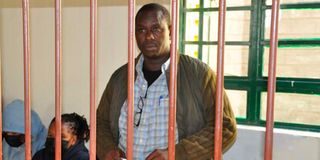
One of the three terror convicts after they were caught and brought back to Kamiti Prison on November 18, 2021.
| Sila Kiplagat | Nation Media GroupNews
Premium
Phones, flash disk ‘to unravel Kamiti prison break puzzle’
What you need to know:
- Preliminary investigations show that the three convicts were relying on Google maps to navigate their way.
- The trio allegedly confessed to the reservists how they were escorted through the main gate at Kamiti.
Two mobile phones and a flash disk are likely to help detectives unravel how three terror convicts escaped from Kamiti Maximum Security Prison and travelled for more than 300 kilometres without detection.
The gadgets were recovered in Kamuluyuni area in Kitui County and are believed to have been disposed of by the three moments before their capture by Kenya Police Reservists.
Also recovered from the scene after three days of combing the spikey thicket is a piece of white paper with three cell phone numbers written on it and a pair of headphones.

Some of the police reservists who captured the terrorists at the scene of the arrest on November 19, 2021.
Mr Komu Kilonzi, the head of the KPR team that recovered the items, suspected the trio was communicating with others in Boni Forest.
“We’ve been combing the thicket since their arrest on Thursday because the terrorists confessed to us they had a mobile phone which got lost in the forest,” said Mr Kilonzi, adding that they had smashed the phones in a bid to destroy evidence.
Preliminary investigations show that Musharaf Abdalla Akhulunga aka Zarkawi, Mohamed Ali Abikar and Joseph Juma Odhiambo aka Yusuf, were relying on Google maps to navigate their way and were in constant communication with their counterparts in Boni.

The three terror convicts who escaped from Kamiti Maximum Security Prison after they were arrested in Kitui County on November 18, 2021.
“Capturing them before they slipped to Somalia was the first main achievement and now we’re happy to have recovered the handsets and other materials that will help with investigations,” said Kitui County police commander Leah Kithei.
A detective said they intend to establish where the phones were bought and the call log data.
They have the IMEI number – International Mobile Equipment Identity –that acts like a fingerprint. It’s a 15-digit number unique to each device.
Rogue prison warders
Using IMEI numbers, detectives are able to establish any mobile number that may have used the device and subsequently retrieve all the call data, messages and even trace the movement of the phone’s owner. The world over, manufacturers share IMEI numbers to enable tracking of smartphones that may have been stolen or compromised.
“In a matter of days, the entire network of who organised the prison escape and facilitated their travel from Kamiti all the way to Kitui will be known. The discoveries will be crucial evidence against the terrorists and all their collaborators,” said a detective.
He said the convicts thought that by crashing the phones, they had destroyed details on their movements to protect their collaborators.
Moments after their capture, the trio allegedly confessed to the reservists how they were escorted through the main gate at Kamiti – a highly guarded correctional facility – and later assisted to Kitui.

Two of the three terror convicts who escaped from Kamiti Maximum Security Prison.
They also told the officers that they were in touch with people in Boni Forest, who were ready to offer bribes in exchange for their freedom.
“They told us that ‘kampuni yetu ni kubwa’ (we have a large organisation) in reference to Al-Shabaab and that their masters won’t hesitate to bail them out,” said Mr Jacob Mutisya, a police reservist.
Security expert Simiyu Werunga said the jailbreak and the eventual capture more than 300km away points to grand corruption and collusion involving rogue prison warders.
Mr Werunga wondered how a convict would have in his possession a flash disk, and yet they have no access to laptops or computers in prison.
“Does it mean these convicts enjoyed certain privileges at Kamiti? Why is it that they all had beards and long hair, which aren’t allowed behind bars? Did the beards grow within the three days of freedom?” he posed.
Suspicious money trail
He said the escape must have been planned over a long period of time with deliberate collusion with prison officers.
“In this saga, there are more questions than answers that all point to corruption within the security ranks. It points that the convicts had access to mobile phones while in jail and freely communicated with fellow terrorists who must have offered hefty bribes to prison warders to facilitate their escape,” he said.
Another curious thing was the similar names written against the three numbers that suggested the trio had wives or it was just a decoy to misguide detectives.
Suspicions that rogue officials were behind numerous jailbreaks that escalated with the escape of three forced President Uhuru Kenyatta to sack Commissioner-General Wycliffe Ogalo last week.
At least 10 warders, including the Kamiti prison boss Charles Mutembei and his deputy Joseph Loklari, were arrested by Anti-Terror Police officers.

Kamiti Maximum Prison head Charles Mutembei during his arrest at Magereza House on November 17, 2021.

Kamiti Maximum Prison boss Charles Mutembei (standing) with his co-accused when he appeared before Kahawa Law Courts on November 18, 2021.
Mr Mutembei, Mr Loklari and four senior warders, Pamela Cherubet, Peter Thuku, Lilian Mukasia and Nicholas Otieno, are accused of aiding the escape of the three terror convicts from Kamiti.
The National Intelligence Service (NIS) has reportedly uncovered a suspicious money trail and communication involving some officers at Kamiti.
Detectives also want to find out why CCTV cameras in the prison were not working on the day the trio escaped, and why the malfunctioning was never reported.
Questions have been raised why the management of Kamiti decided not to house the trio with other terrorism suspects at Condemn G Block. They were locked up in cell number 6 Block A, which has less security.
Read part 2 about how Kitui is a Wild Wild East that serves as a safe haven for terrorists





